I'm applying a shader as a texture to a plane in an isometric scene. The plane lays flat with x,z dimensions. I'm having trouble getting the shader pattern to match the isometric perspective as the scene it's in.
Here's an example where the shader rotates with the plane (like a regular texture) by passing in the orientation as a uniform.
Here's a "2d" (orthographic) projection of the shader texture:
var TWO_PI = Math.PI * 2;
var PI = Math.PI;
var width = window.innerHeight - 50;
var height = window.innerHeight - 50;
var aspect = width / height;
var planeSize = width * 0.75;
var clock = new THREE.Clock();
var camera, scene, renderer;
var plane, geom_plane, mat_plane;
function init() {
// ---------- scene
scene = new THREE.Scene();
// ---------- plane
var plane_w = planeSize;
var plane_h = planeSize;
var geom_plane = new THREE.PlaneGeometry(plane_w,
plane_h,
0);
var mat_plane = new THREE.MeshBasicMaterial({
color: 0xffff00,
side: THREE.DoubleSide
});
var shaderMaterial_plane = new THREE.ShaderMaterial({
uniforms: {
u_resolution: {
value: new THREE.Vector2(planeSize, planeSize)
},
u_rotation_x: {
value: performance.now() * 0.001
},
u_rotation_y: {
value: performance.now() * 0.001
}
},
vertexShader: document.getElementById('vertexshader').textContent,
fragmentShader: document.getElementById('fragmentshader').textContent,
blending: THREE.NormalBlending,
depthTest: true,
transparent: true
});
plane = new THREE.Mesh(geom_plane, shaderMaterial_plane);
scene.add(plane);
// ---------- cam
camera = new THREE.OrthographicCamera(width / -2, width / 2, height / 2, height / -2, 1, 5000);
camera.position.set(0, 0, planeSize);
camera.lookAt(scene.position);
// ---------- renderer
renderer = new THREE.WebGLRenderer({
antialias: false,
alpha: true
});
renderer.setSize(width, height);
renderer.setClearColor(0x000000);
document.body.appendChild(renderer.domElement);
}
function animate() {
requestAnimationFrame(animate);
var time = performance.now() * 0.001;
plane.material.uniforms.u_rotation_x.value = Math.sin(time * 0.2);
plane.material.uniforms.u_rotation_y.value = Math.cos(time * 0.2);
var delta = clock.getDelta();
render();
}
function render() {
renderer.render(scene, camera);
}
init();
animate();<script type="x-shader/x-vertex" id="vertexshader">
varying vec2 vUv;
void main() {
vUv = uv;
gl_Position = projectionMatrix * modelViewMatrix * vec4(position, 1.0);
}
</script>
<script type="x-shader/x-fragment" id="fragmentshader">
uniform vec2 u_resolution; // Canvas size (width,height)
uniform float u_rotation_x;
uniform float u_rotation_y;
mat2 rotate2d(vec2 _angles){
return mat2(_angles.x,
-_angles.x,
_angles.y,
_angles.y);
}
float map(float value, float min1, float max1, float min2, float max2) {
return min2 + (value - min1) * (max2 - min2) / (max1 - min1);
}
void main() {
vec2 st = gl_FragCoord.xy/u_resolution.xy;
vec3 color = vec3(1.0,1.0,1.0);
float gradientLength = 0.2;
float t = 18.;
// move matrix in order to set rotation pivot point to center
st -= vec2(0.5);
// rotate
vec2 u_rotation = vec2(u_rotation_x, u_rotation_y);
st = rotate2d(u_rotation) * st;
// move matrix back
st += vec2(0.5);
// apply gradient pattern
vec2 p = vec2(floor(gl_FragCoord.x), floor(gl_FragCoord.y));
float pp = clamp(gl_FragCoord.y,-0.5,st.y);
float val = mod((pp + t), gradientLength);
float alpha = map(val, 0.0, gradientLength, 1.0, 0.0);
gl_FragColor = vec4(color,alpha);
}
</script>
<div id="threejs_canvas"></div>
<script src="https://threejs.org/build/three.min.js"></script>And here it is on the plane in isometric space (with the same rotation):
var TWO_PI = Math.PI * 2;
var PI = Math.PI;
var width = window.innerHeight - 50;
var height = window.innerHeight - 50;
var aspect = width / height;
var canvasCubeSize = width;
var clock = new THREE.Clock();
var camera, scene, renderer;
var wire_cube;
var plane, geom_plane, mat_plane;
function init() {
// ---------- scene
scene = new THREE.Scene();
// ---------- wire cube
var wire_geometry = new THREE.BoxGeometry(canvasCubeSize / 2, canvasCubeSize / 2, canvasCubeSize / 2);
var wire_material = new THREE.MeshBasicMaterial({
wireframe: true,
color: 0xff0000
});
wire_cube = new THREE.Mesh(wire_geometry, wire_material);
scene.add(wire_cube);
// ---------- plane
var plane_w = canvasCubeSize / 2;
var plane_h = plane_w;
var geom_plane = new THREE.PlaneGeometry(plane_w,
plane_h,
0);
var mat_plane = new THREE.MeshBasicMaterial({
color: 0xffff00,
side: THREE.DoubleSide
});
var shaderMaterial_plane = new THREE.ShaderMaterial({
uniforms: {
u_time: {
value: 1.0
},
u_resolution: {
value: new THREE.Vector2(canvasCubeSize, canvasCubeSize)
},
u_rotation_x: {
value: wire_cube.rotation.y
},
u_rotation_y: {
value: wire_cube.rotation.y
}
},
vertexShader: document.getElementById('vertexshader').textContent,
fragmentShader: document.getElementById('fragmentshader').textContent,
blending: THREE.NormalBlending,
depthTest: true,
transparent: true
});
plane = new THREE.Mesh(geom_plane, shaderMaterial_plane);
plane.rotation.x = -PI / 2;
wire_cube.add(plane);
// ---------- cam
camera = new THREE.OrthographicCamera(width / -2, width / 2, height / 2, height / -2, 1, 5000);
camera.position.set(canvasCubeSize, canvasCubeSize, canvasCubeSize);
camera.lookAt(scene.position);
// ---------- renderer
renderer = new THREE.WebGLRenderer({
antialias: false,
alpha: true
});
renderer.setSize(width, height);
renderer.setClearColor(0x000000);
document.body.appendChild(renderer.domElement);
}
function animate() {
requestAnimationFrame(animate);
var time = performance.now() * 0.001;
wire_cube.rotation.y = time * 0.2;
if (wire_cube.rotation.y >= TWO_PI) {
wire_cube.rotation.y -= TWO_PI;
}
plane.material.uniforms.u_time.value = time * 0.005;
plane.material.uniforms.u_rotation_x.value = Math.sin(wire_cube.rotation.y);
plane.material.uniforms.u_rotation_y.value = Math.cos(wire_cube.rotation.y);
var delta = clock.getDelta();
render();
}
function render() {
renderer.render(scene, camera);
}
init();
animate();<script type="x-shader/x-vertex" id="vertexshader">
varying vec2 vUv;
void main() {
vUv = uv;
gl_Position = projectionMatrix * modelViewMatrix * vec4(position, 1.0);
}
</script>
<script type="x-shader/x-fragment" id="fragmentshader">
uniform vec2 u_resolution; // Canvas size (width,height)
uniform float u_rotation_x;
uniform float u_rotation_y;
mat2 rotate2d(vec2 _angles){
return mat2(_angles.x,
-_angles.x,
_angles.y,
_angles.y);
}
float map(float value, float min1, float max1, float min2, float max2) {
return min2 + (value - min1) * (max2 - min2) / (max1 - min1);
}
void main() {
vec2 st = gl_FragCoord.xy/u_resolution.xy;
vec3 color = vec3(1.0,1.0,1.0);
float gradientLength = 0.2;
float t = 18.;
// move matrix in order to set rotation pivot point to center
st -= vec2(0.5);
// rotate
vec2 u_rotation = vec2(u_rotation_x, u_rotation_y);
st = rotate2d(u_rotation) * st;
// move matrix back
st += vec2(0.5);
// apply gradient pattern
vec2 p = vec2(floor(gl_FragCoord.x), floor(gl_FragCoord.y));
float pp = clamp(gl_FragCoord.y,-0.5,st.y);
float val = mod((pp + t), gradientLength);
float alpha = map(val, 0.0, gradientLength, 1.0, 0.0);
gl_FragColor = vec4(color,alpha);
}
</script>
<div id="threejs_canvas">
</div>
<script src="https://threejs.org/build/three.min.js"></script>if snippet output is too small see here
The rotation illustrates how the shader isn't mimicking isometric perspective. Notice how the shader pattern doesn't stay fixed relative to the plane's corners as they rotate.
Here's the frag shader:
uniform vec2 u_resolution; // canvas size (width,height)
uniform float u_rotation_x;
uniform float u_rotation_y;
mat2 rotate2d(vec2 _angles){
return mat2(_angles.x,
-_angles.x,
_angles.y,
_angles.y);
}
float map(float value, float min1, float max1, float min2, float max2) {
return min2 + (value - min1) * (max2 - min2) / (max1 - min1);
}
void main() {
vec2 st = gl_FragCoord.xy/u_resolution.xy;
vec3 color = vec3(1.0,1.0,1.0);
float gradientLength = 0.2;
float t = 18.;
// move matrix in order to set rotation pivot point to center
st -= vec2(0.5);
// rotate
vec2 u_rotation = vec2(u_rotation_x, u_rotation_y);
st = rotate2d(u_rotation) * st;
// move matrix back
st += vec2(0.5);
// apply gradient pattern
vec2 p = vec2(floor(gl_FragCoord.x), floor(gl_FragCoord.y));
float pp = clamp(gl_FragCoord.y,-0.5,st.y);
float val = mod((pp + t), gradientLength);
float alpha = map(val, 0.0, gradientLength, 1.0, 0.0);
gl_FragColor = vec4(color,alpha);
}
Could someone help me understand how to "warp" the matrix in the shader so that when it rotates, it mimics the rotation of a flat plane in isometric space?
Edit: I'm wondering if warping the matrix and applying accurate rotation should be broken up into two separate issues? I'm playing around with changing the rotation speed based on 0 to TWO_PI orientation but maybe that's a solution specific to this example...

